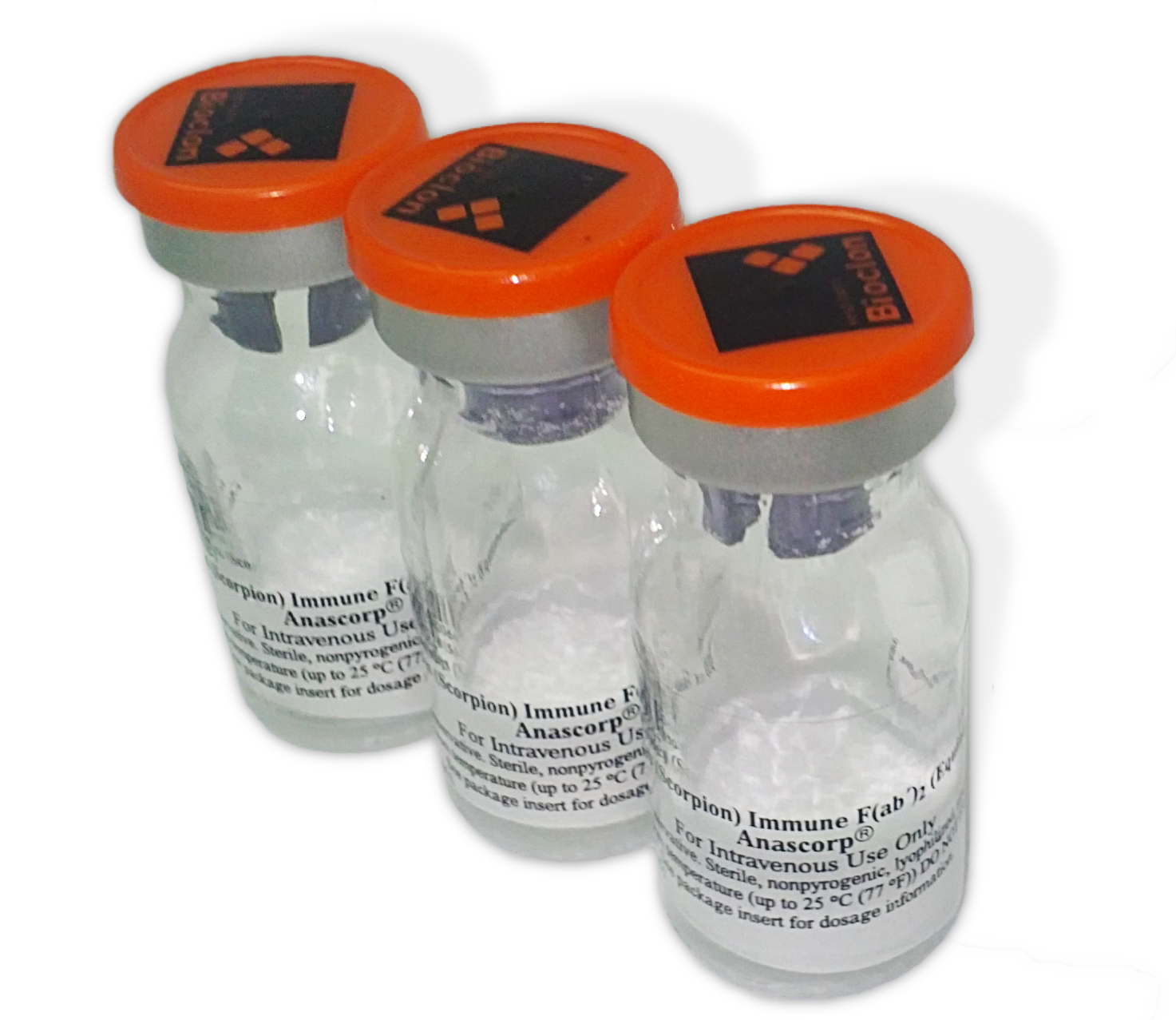ABOUT ANASCORP
Dosing Regimen
Initial Dose1
The initial dose of ANASCORP is 3 vials and should be prepared as follows:

Reconstitute the contents of each vial with 5 milliliters of sterile normal saline (0.9% NaCl) and mix by continuous gentle swirling.

Combine the contents of the reconstituted vials promptly and further dilute to a total volume of 50 milliliters with sterile normal saline (0.9% NaCl).

Inspect the solution visually for particulate matter and discoloration prior to administration. Do not use if turbid.
Following these steps, infuse ANASCORP intravenously over 10 minutes. Discard any partially used vials

If an anaphylactic reaction occurs during the infusion, terminate administration at once and administer appropriate emergency medical care. Advise patients to contact the physician or emergency department immediately if they experience any signs and symptoms of delayed allergic reactions or serum sickness up to 14 days following hospital discharge.
It is important to monitor the patient closely during and up to 60 minutes following the completion of infusion to determine if clinically important signs of envenomation have resolved.
Delayed allergic reactions (serum sickness) may occur following treatment with ANASCORP. Patient monitoring with a follow-up visit is recommended.
Additional Dosing1
Additional doses may be used if needed, as follows:

Infuse 1 vial at a time at intervals of 30 to 60 minutes.

Reconstitute the contents with 5 milliliters of sterile normal saline (0.9% NaCl) and mix by continuous gentle swirling.

Further dilute to a total volume of 50 milliliters with sterile normal saline (0.9% NaCl). Inspect the solution visually for particulate matter or discoloration prior to administration.
Following these steps, infuse intravenously over 10 minutes, then monitor the patient closely during and up to 60 minutes following the completion of infusion to determine if clinically important signs of envenomation have resolved. Discard any partially used vials.
Important Stocking Considerations1
- Initial dose is 3 vials.
- Stocking recommendation is a minimum of 5 vials per patient. Extended holiday weekends may require having additional vials on hand.
- ANASCORP is only available from AnovoRx: 1-844-472-7389.
- 4-year expiration dating.
- Free replacement for expired, unopened vials.


BE PREPARED
Why send your patient to the ICU when in most cases you can send them home in under 4 hours?
Make sure you are prepared for a bark scorpion sting emergency. Do your best to alleviate hardships on families due to hospital admissions, transfer costs, and complications of supportive care. Use ANASCORP to treat clinical signs of scorpion envenomation in your Emergency Department.
- ANASCORP [centruroides (scorpion) immune F(ab’)2 (equine)] injection Prescribing Information. Rare Disease Therapeutics, Inc.; Franklin, TN. August 2022.
INDICATION
ANASCORP® [centruroides (scorpion) immune F(ab')2 (equine) injection] is an equine-derived antivenom indicated for treatment of patients with clinical signs of scorpion envenomation.
IMPORTANT SAFETY INFORMATION
INDICATION
ANASCORP® [centruroides (scorpion) immune F(ab')2 (equine) injection] is an equine-derived antivenom indicated for treatment of patients with clinical signs of scorpion envenomation.
IMPORTANT SAFETY INFORMATION
CONTRAINDICATIONS
None.
WARNINGS AND PRECAUTIONS
Hypersensitivity Reactions
Severe hypersensitivity reactions, including anaphylaxis, may occur with ANASCORP. Close patient monitoring for hypersensitivity reactions and readiness with intravenous therapy using epinephrine, corticosteroids, and diphenhydramine hydrochloride is recommended during the infusion of ANASCORP. If an anaphylactic reaction occurs during the infusion, terminate administration at once and administer appropriate emergency medical care. Patients with known allergies to horse protein are particularly at risk for an anaphylactic reaction. Patients who have had previous therapy with ANASCORP or another equine antivenom/antitoxin may have become sensitized to equine protein and be at risk for a severe hypersensitivity reaction.
Delayed Allergic Reactions
(Serum Sickness) Monitor patients with follow-up visit(s) for signs and symptoms of delayed allergic reactions or serum sickness (e.g., rash, fever, myalgia, arthralgia), and treat appropriately if necessary. Eight out of 1,534 (0.5%) patients in the clinical trials exhibited symptoms suggestive of serum sickness.
Transmissible Infectious
Agents ANASCORP is made from equine (horse) plasma, it may therefore carry a risk of transmitting infectious agents, e.g., viruses.
Reaction to Cresol
Trace amounts of cresol from the manufacturing process are contained in ANASCORP. Localized reactions and generalized myalgias have been reported with the use of cresol as an injectable excipient.
ADVERSE REACTIONS
The most common adverse reactions observed in ? 2% of patients in the clinical studies for ANASCORP were: vomiting, pyrexia, rash, nausea and pruritus.
See Full Prescribing Information.
To report SUSPECTED ADVERSE REACTIONS, contact Rare Disease Therapeutics, Inc., at 1-844-472-7389 or by email at safety@raretx.com, or FDA at 1-800-FDA-1088 or www.fda.gov/medwatch.
ANS-ISIF-001
ANASCORP® [centruroides (scorpion) immune F(ab')2 (equine) injection] is an equine-derived antivenom indicated for treatment of patients with clinical signs of scorpion envenomation.
IMPORTANT SAFETY INFORMATION
CONTRAINDICATIONS
None.
WARNINGS AND PRECAUTIONS
Hypersensitivity Reactions
Severe hypersensitivity reactions, including anaphylaxis, may occur with ANASCORP. Close patient monitoring for hypersensitivity reactions and readiness with intravenous therapy using epinephrine, corticosteroids, and diphenhydramine hydrochloride is recommended during the infusion of ANASCORP. If an anaphylactic reaction occurs during the infusion, terminate administration at once and administer appropriate emergency medical care.
Patients with known allergies to horse protein are particularly at risk for an anaphylactic reaction. Patients who have had previous therapy with ANASCORP or another equine antivenom/antitoxin may have become sensitized to equine protein and be at risk for a severe hypersensitivity reaction.
Delayed Allergic Reactions (Serum Sickness)
Monitor patients with follow-up visit(s) for signs and symptoms of delayed allergic reactions or serum sickness (e.g., rash, fever, myalgia, arthralgia), and treat appropriately if necessary. Eight out of 1,534 (0.5%) patients in the clinical trials exhibited symptoms suggestive of serum sickness.
Transmissible Infectious Agents
ANASCORP is made from equine (horse) plasma, it may therefore carry a risk of transmitting infectious agents, e.g., viruses.
Reaction to Cresol
Trace amounts of cresol from the manufacturing process are contained in ANASCORP. Localized reactions and generalized myalgias have been reported with the use of cresol as an injectable excipient.
ADVERSE REACTIONS
The most common adverse reactions observed in ≥ 2% of patients in the clinical studies for ANASCORP were: vomiting, pyrexia, rash, nausea and pruritus.
Please see complete Prescribing Information.
To report SUSPECTED ADVERSE REACTIONS, contact Rare Disease Therapeutics, Inc., at 1-844-472-7389 or by email at safety@raretx.com, or contact FDA at 1-800-FDA-1088 or www.fda.gov/medwatch.
ANS-ISIF-001

2550 Meridian Blvd. Suite 150
Franklin, TN 37067
To order ANASCORP, call:
1-844-4RareTx (1-844-472-7389)
ANASCORP is exclusively distributed by:
AnovoRx www.anovorx.com
![ANASCORP® [centruroides (scorpion) immune F(ab')? (equine) injection]](https://www.anascorp-us.com/wp-content/uploads/2024/05/AnascorpLogo_color-tall.png)